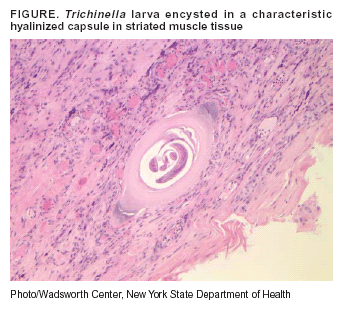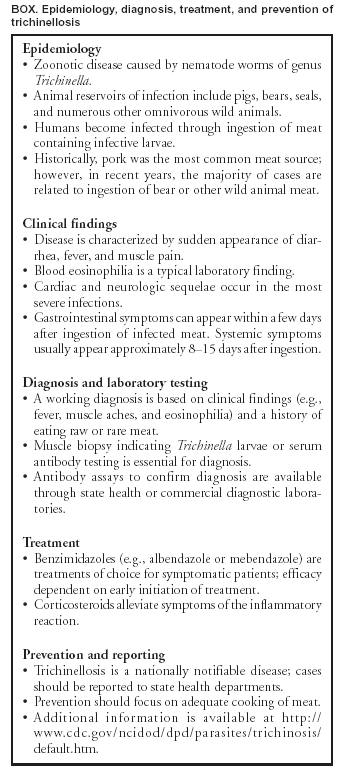 |
|
|
|
|
|
|
| ||||||||||
|
|
|
|
|
|
|
||||
| ||||||||||
|
|
|
|
|
Persons using assistive technology might not be able to fully access information in this file. For assistance, please send e-mail to: mmwrq@cdc.gov. Type 508 Accommodation and the title of the report in the subject line of e-mail. Trichinellosis Associated with Bear Meat --- New York and Tennessee, 2003Trichinellosis is a parasitic infection caused by tissue-dwelling Trichinella roundworms and is associated traditionally with ingestion of pork from infected domestic swine. As a result of improvements in swine production, trichinellosis has declined steadily in the United States (1). However, infection also can result from eating the meat of wild animals. During 1997--2001, a total of 72 cases of trichinellosis (median: 12 cases annually; range: 11--23 cases) were reported to CDC; the majority of these infections were associated with eating wild game, predominantly bear. This report describes three cases of trichinellosis associated with eating undercooked bear meat reported from New York and Tennessee in 2003. To prevent trichinellosis, persons should cook meat, particularly wild game, to an internal temperature of 160º F (71º C) (1). Case ReportsNew York. In December 2003, the New York State Department of Health was notified of a trichinellosis case in a man aged 54 years who resided in Franklin County. The patient had been hospitalized in a tertiary care center in early November with a 3-week history of diaphoresis, fever, weakness, tachycardia, diarrhea, an 8-pound weight loss, and dry cough. Laboratory testing indicated an elevated white blood cell (WBC) count (20,600/mm3 [normal: 5,000--10,000/mm3] with 33% eosinophils), hyponatremia (123 mmol sodium/L [normal: 136--145 mmol sodium/L]), elevated lactate dehydrogenase (LDH) (823 U/L [normal: 313--618 U/L]), and elevated creatinine phosphokinase (CPK) (1,554 U/L [normal: 10--250 U/L]). The patient reported eating approximately 2 pounds of nearly raw bear meat during several meals 2 weeks before onset of symptoms. The meat had come from a custom slaughter house in upstate New York and had been frozen at -4° F (-20° C) for approximately 1 week before ingestion. Because of suspicion of trichinellosis infection, albendazole and corticosteroids were administered. Weakness and fatigue persisted through late December 2003. The patient recovered fully by February 2004. Serum specimens collected on the third hospital day for antibody testing of Trichinella and other helminths were reported negative by a commercial reference laboratory. A serum specimen collected on the 11th hospital day and sent to CDC for Trichinella antibody testing was positive by enzyme-linked immunoassay. The New York State Department of Environmental Conservation (NYSDEC)'s Wildlife Pathology Unit recovered nine packages of bear meat from multiple bears from the patient's freezer and identified Trichinella spp. larvae in five of the seven packages examined. Muscle digestion with artificial gastric juice yielded 0.5--48.0 larvae per gram of bear meat. The remaining two packages of meat were examined by the U.S. Department of Agriculture (USDA), which identified Trichinella nativa by polymerase chain reaction (PCR). Tennessee. In November 2003, the Tennessee Department of Health received a report of two cases of trichinellosis in persons residing in Claiborne County. In early October, a man aged 38 years and a woman aged 54 years were admitted to a hospital with 7-day and 14-day histories of fever, respectively, chills, headache, myalgias, arthralgias, and facial swelling. The man's WBC count was 14,600/mm3, with 24% eosinophils, 13% lymphocytes, and 2% monocytes. The woman's WBC count was 16,200/mm3, with 28% eosinophils, 13% lymphocytes, and 3% monocytes. Serum obtained from both patients tested positive for Trichinella antibodies, and both were started on a course of albendazole and corticosteroids. Both patients have recovered fully. Questioning of the patients revealed that, in late August 2003, the man had shot a black bear (Ursus americanus) in Canada. The bear was field dressed, and selected meat was packed on ice for transport to Tennessee. On August 31, the man and woman prepared and cooked the bear meat on an outdoor grill for themselves and four other persons. The man and woman ate their steaks medium rare; the four others ate their steaks well done. The remaining meat was packaged for storage in a household freezer, and the family continued to consume the meat during September. In December, samples of the bear meat were examined histologically at the University of Tennessee College of Veterinary Medicine. Numerous Trichinella larvae were observed encysted in characteristic hyalinized capsules in the striated muscle tissue (Figure). The larvae had diameters of approximately 30--35 µm, and the diagnostic morphology of the stichosome was apparent at high (400x) magnification. Further testing of the bear meat at USDA recovered live larvae (estimated infection intensity: 350--400 larvae per gram of muscle), and PCR results were consistent with the genotype T. nativa. Reported by: P Smith, MD, M Eidson, DVM, A Willsey, DVM, B Wallace, MD, M Kacica, MD, G Johnson, M Frary-Pelletieri, MS, A Burns, MS, New York State Dept of Health; W Stone, ScD, New York State Dept of Environmental Conservation. J Narro, MD, Univ of Tennessee Medical Center; C Faulkner, PhD, D Rotstein, DVM, Univ of Tennessee College of Veterinary Medicine, Knoxville; L Sheeler, PhD, P Erwin, MD, Tennessee Dept of Health. B Kirkpatrick, MD, Univ of Vermont College of Medicine, Burlington, Vermont. D Zarlenga, PhD, U.S. Dept of Agriculture. P Schantz, VMD, Div of Parasitic Diseases, National Center for Infectious Diseases; F Coronado, MD, EIS Officer, CDC. Editorial Note:Undercooked wild game has emerged in recent years as a predominant source for infection with Trichinella (2,3) (Box). During 1997--2001, of the 52 (72%) U.S. cases in which a source of infection was known or suspected, pork products were associated with 21 (40%) cases, and wild game was associated with 31 (60%), including 29 cases linked to bear meat (1). In Canada, the majority of trichinellosis outbreaks during the previous three decades were attributed to eating meat from wild animals (3). Increasing local bear populations combined with the popularity of bear hunting in the northeastern United States and Canada might contribute to increased cases of Trichinella infection. In 2003, in New York state, a record number of approximately 1,850 bears were reported killed by hunters (4). NYSDEC provides information about trichinellosis and proper cooking instructions for wild game with each bear-hunting license issued. However, the meat from hunted animals often is given away and eaten by persons who are unaware of the need to cook the meat thoroughly enough to kill larvae. Multiple exposures also can occur when bear meat is served at wild game parties. Whereas freezing at specified temperatures kills T. spiralis larvae in pork, T. nativa is a freeze-resistant species that remains viable after freezing, even for months or years. The three cases described in this report were the result of eating improperly cooked bear meat infected with T. nativa. Educational messages concerning the risks of eating meat cooked improperly do not always reach persons at risk for trichinellosis (2). To prevent future cases of trichinellosis, health-education messages should target wild game hunters who are most at risk for Trichinella infection (3). Information on the parasite and proper cooking should be made available at points of wild game distribution, such as custom butchers and game meat processors. To prevent trichinellosis, consumers should be advised to monitor for an adequate cooking temperature of 160° F (71° C) (1) and observe the color and texture of the meat during cooking. A change in color from red to dark gray throughout and a change in texture such that muscle fibers are easily separated from each other are indicators that meat has been rendered safe to eat (3,5). However, game meats such as bear are very dark, making interpretation of color changes difficult; for these, adequate cooking might be better judged by texture and temperature. USDA recommends a higher temperature to allow for different cooking methods (e.g., microwave cooking) that might result in uneven temperature distributions throughout the meat (6). Symptoms associated with classic trichinellosis from T. spiralis include fever, facial edema, myalgias, muscle swelling, and weakness. However, as demonstrated in the T. nativa cases described in this report, some of these symptoms might be absent. Eosinophilia typically is present in cases of trichinellosis, and elevated blood levels of muscle enzymes (e.g., LDH and CPK) also are common. Physicians should consider trichinellosis in any ill person with eosinophilia and a history of eating wild game. Suspected cases should be reported to state health departments. References
Figure  Return to top. Box  Return to top.
Disclaimer All MMWR HTML versions of articles are electronic conversions from ASCII text into HTML. This conversion may have resulted in character translation or format errors in the HTML version. Users should not rely on this HTML document, but are referred to the electronic PDF version and/or the original MMWR paper copy for the official text, figures, and tables. An original paper copy of this issue can be obtained from the Superintendent of Documents, U.S. Government Printing Office (GPO), Washington, DC 20402-9371; telephone: (202) 512-1800. Contact GPO for current prices. **Questions or messages regarding errors in formatting should be addressed to mmwrq@cdc.gov.Page converted: 7/15/2004 |
|||||||||
This page last reviewed 7/15/2004
|